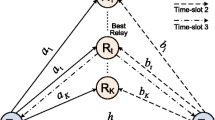Abstract
Cooperative communications have great potentials in performance enhancement via deploying relay nodes. However, these kinds of benefits usually come at the cost of more system parameters to be estimated. This fact definitely reduces the efficiency of wireless systems and then it motivates the research on the blind algorithms for cooperative communications that need fewer parameters. In this paper, we investigate the parallel factors (PARAFAC) decomposition-based blind signal recovery algorithm design for two-hop amplify-and-forward (AF) multi-carrier cooperative networks. In particular, the uniqueness of the PARAFAC decomposition used in the proposed algorithm is first investigated in detail, and then the performance of signal recovery is analyzed. Finally, the simulation results assess the performance of our proposed algorithm.
Similar content being viewed by others
References
Xing C W, Ma S D, Wu Y C. Robust joint design of linear relay precoder and destination equalizer for dual-hop amplify-and-forward MIMO relay systems. IEEE Trans Signal Process, 2010, 58: 2273–2283
Xing C W, Ma S D, Wu Y C, et al. Transceiver design for dual-hop non-regenerative MIMO-OFDM relay systems under channel ulncertainties. IEEE Trans Signal Process, 2010, 58: 6325–6339
Edfors O, Sandell M, van de Beek J, et al. An Introduction to Orthogonal-Frequency Division Multiplexing. Research Report 1996: 16, Division of Signal Processing, Luleå University of Technology, 1996
Yang S, Belfiore J-C. Optimal space-time codes for the MIMO amplify-and-forward cooperative channel. IEEE Trans Inf Theory, 2007, 53: 647–663
Herdin M. A chunk based OFDM amplify-and-forward relaying scheme for 4G mobile radio systems. In: Proceedings of IEEE ICC 2006, Istanbul, 2006. 4507–4512
Kolda T G, Bader B W. Tensor decompositions and applications. SIAM Rev, 2009, 51: 455–500
Carroll J D, Chang J J. Analysis of individual differences in multidimensional scaling via an N-way generalization of “Eckart-Young” decomposition. Psychometrika, 1970, 35: 283–319
Harshman R A. Foundations of the PARAFAC procedure: models and conditions for an ‘explanatory’ multi-modal factor analysis. UCLA Work Papers Phonetics, 1970, 16: 1–84
Sidiropoulos N D, Giannakis G B, Bro R. Parallel factor analysis in sensor array processing. IEEE Trans Signal Process, 2000, 48: 2377–2388
Sidiropoulos N D, Bro R, Giannakis G B. Blind PARAFAC receivers for DS/CDMA systems. IEEE Trans Signal Process, 2000, 48: 810–823
Jiang T, Sidiropoulos N D. A direct blind receiver for SIMO and MIMO OFDM systems subject to unknown frequency offset and multipath. In: Proceedings of the 4th IEEE Workshop on Signal Processing Advances in Wireless Communications (SPAWC), Rome, 2003. 358–362
Roemer F, Haardt M. Tensor-based channel estimation and iterative refinements for two-way relaying with multiple antennas and spatial reuse. IEEE Trans Signal Process, 2010, 58: 5720–5735
Kibangou A Y, De Almeida A L F. Distributed PARAFAC based DS-CDMA blind receiver for wireless sensor networks. In: Proceedings of IEEE 11th Workshop on Signal Processing Advances in Wireless Communications (SPAWC), Marrakech, 2010. 1–5
Kibangou A Y, De Almeida A L F. Distributed Khatri-Rao space-time coding and decoding for cooperative networks. In: Proceedings of the 19th European Signal Processing Conference (EUSIPCO), Barcelona, 2011. 809–813
Fernandes C A R, De Almeida A L F, Da Costa D B. Unified tensor modeling for blind receivers in multiuser uplink cooperative systems. IEEE Signal Process Lett, 2012, 19: 247–250
Fernandes A R, De Almeida A L F, Da Costa D B. Blind receiver for amplify-and-forward cooperative diversity scheme. In: Proceedings of IEEE 12th International Workshop on Signal Processing Advances in Wireless Communications (SPAWC), San Francisco, 2011. 546–550
Kruskal J B. Three-way arrays: rank and uniqueness of trilinear decompositions, with application to arithmetic complexity and statistics. Linear Algebra Appl, 1977, 18: 95–138
Kruskal J B. Rank decomposition, and uniqueness for 3-way and N-way arrays. In: Coppi R, Bolasco S, eds. Multiway Data Analysis. The Netherlands: North-Holland, 1989. 7–18
Foschini G J. Layered space-time architecture for wireless communications in a fading environment when using multiple antennas. Bell Labs Tech J, 1996, 1: 41–59
De Almeida A L F, Favier G, Mota J C M. Constrained tensor Modeling approach to blind multiple-antenna CDMA schemes. IEEE Trans Signal Process, 2008, 56: 2417–2428
Sidiropoulos N D, Budampati R S. Khatri-Rao space-time codes. IEEE Trans Signal Process, 2002, 50: 2396–2407
De Almeida A L F, Favier G, Mota J C M. PARAFAC-based unified tensor modeling for wireless communication systems with application to blind multiuser equalization. Signal Process, 2007, 87: 337–351
Author information
Authors and Affiliations
Corresponding author
Rights and permissions
About this article
Cite this article
Wang, Z., Wang, J., Xing, C. et al. Tensor-based blind signal recovery for multi-carrier amplify-and-forward relay networks. Sci. China Inf. Sci. 57, 1–11 (2014). https://doi.org/10.1007/s11432-014-5162-0
Received:
Accepted:
Published:
Issue Date:
DOI: https://doi.org/10.1007/s11432-014-5162-0




